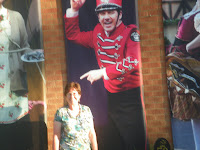Alan and I are having so much fun this summer, we won't know how to go back to work. We spent Monday through Wednesday on a short vacation to the Shakespeare Festival to see The Music Man and Richard III.
On the way to Cedar City, we decided to stop at the Topaz Internment Center and museum outside of Delta. I was supposed to call "Jane" when we got into Delta so she could show us around the internment camp. We had no service when we got there, so we tried to find the places ourselves. The internment camp wasn't on the GPS or MapQuest, but we were able to get to Delta thanks to their help. When we were about to give up finding either the internment camp or museum when we started to see a few road signs.This is what we found:
The buildings are gone, but there are two markers to honor the Japanese people who were sent to Topaz during World War II. Eight to ten thousand people lived in barracks that covered less than one mile. Below: The large marker told where the camp was, and the small markers labeled each block.
We were frustrated because we drove all over trying to find the museum thinking it was at the camp. Finally, we ate lunch by the markers, took pictures to prove we'd been at the camp, then headed out of town to Cedar City.
We found the museum by a lucky accident. It was not by the camp at all. We glimpsed a sign while driving through Delta on the way out of town. We asked for Jane, and the museum employees said she had called several times looking for us. It turns out she is a high school teacher, and she has started this museum. She's passionate about it, and when she found out we'd made it to the museum, she came over and spent an hour with us.
Each family lived in an area about 12' by 12'. This particular room had three cots, a crib, a stove, the green chairs you see below, and a dresser. If the families wanted furniture, they had to make it. The reddish wooden chairs below were made from a packing box one family sent to themselves. Families were not allowed to cook in their barracks. They went outside to a mess hall and to the latrine.
The museum owns one of the recreation buildings that was at the camp. The government sold all the barracks after the war to try to recoup their costs. A farmer who had bought one of the barracks to store his grain later donated the building, and the museum began. (This was just a couple of years ago.)
The barracks were covered with tar paper, and that was as finished as each barrack got. Freezing in the winters, hot in the summer. Each barrack housed 3-4 families.
We were frustrated as we tried to connect with Jane, but I'm so glad we finally found her. She was a wonderful guide.
Cedar City was next. We checked into our motel in time to eat and to see Harry Potter. We both loved the movie. I went expecting to be disappointed, but I loved almost all of it.
Tuesday we took a backstage tour at the festival. We learned that a "Vomitory" is a ramp that leads from the theater up to backstage. We also got a view of the many wigs used for the plays.
We got to the university early so we could sit on their beautiful campus and read. I was diligently trying to finish Richard III before the play that night. Alan was working on George Washington: A Life.
Our traditional "picture place," by the flowers on the corner of the auditorium lot.
If I ever get big pots in our yard, I want them to look like this:
I learned that all the plants that are labeled on the beautiful grounds are actually mentioned in one of Shakespeare's plays. I love trivia like this!
Finally it was time for The Music Man with Brian Vaughn, our favorite festival actor, as Harold Hill. He was amazing! We also loved Winthrop and the dancing teenagers. Here I am sharing a moment with Professor Hill. And here are his actual hats in his dressing room.
Fun Facts about The Music Man.- The story is autobiographical. When Meredith Wilson wrote his autobiography, he would write a story about his life, it would often turn into a song. He decide to write a musical with his experiences, and when he was finished he had a 5 hour show with 44 songs. No one wanted to produce a five-hour play, so Wilson finally gave it to a playwright who shortened it for him. The extra songs were also made into a musical: The Unsinkable Molly Brown.
- Marian the librarian was a woman Meredith Wilson met during World War II. She was a medical librarian from Provo, Utah.
- Robert Preston was not going to try out for Professor Hill because he wasn't a good singer. He was talked into it, and auditioned by half talking, half singing the "Trouble" song. Wilson loved it that way, and it has been performed that way ever since.
It's the story of a man who will do anything to be king. He kills many people as he claws his way to the top. But because he has stepped on so many people, he has very few supporters by the time he is king, and he is overthrown in only two years.
Wednesday morning we drove home by way of Cedar Breaks and wildflowers. We had a great time!






























fun! i'm glad you found the museum and were able to meet up with jane. interesting about the internment camps too.
ReplyDelete